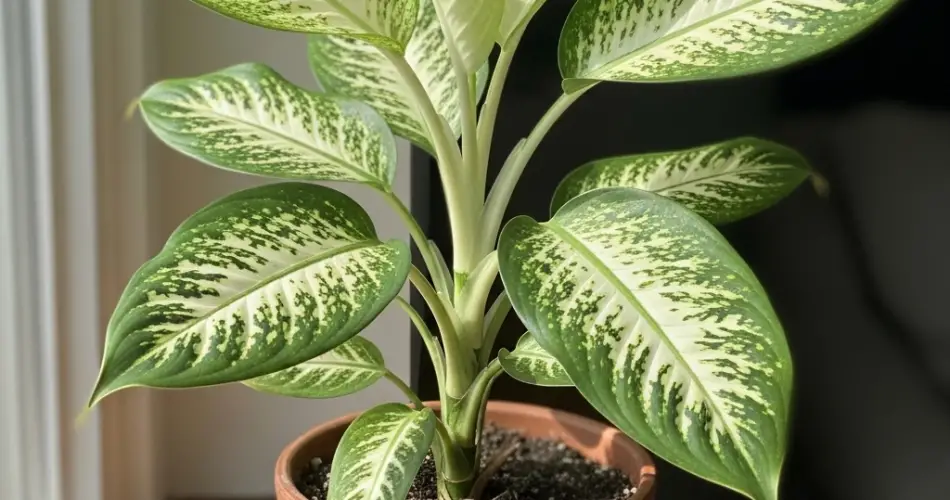Dieffenbachia, commonly known as dumb cane, is a popular houseplant prized for its large, variegated leaves and striking tropical appearance. While it is relatively easy to grow indoors, one of the most common problems plant owners face is leaf drop. Improper watering is often the primary culprit, as Dieffenbachia’s shallow roots are sensitive to both overwatering and underwatering. Understanding the plant’s watering needs and implementing proper care routines can keep leaves lush, green, and healthy throughout the year.
Understanding the Cause of Leaf Drop
Leaf drop in Dieffenbachia is typically a stress response. Watering practices play a significant role:
-
Overwatering: Excess water can suffocate the roots, leading to root rot. When roots are compromised, the plant cannot absorb nutrients or moisture efficiently, causing leaves to yellow and fall.
-
Underwatering: Insufficient moisture can cause leaves to wilt, dry, and eventually drop.
-
Inconsistent watering: Fluctuating soil moisture creates stress, resulting in sporadic leaf loss.
By identifying the right watering balance, you can prevent leaf drop and support consistent growth.
Recognizing Signs of Improper Watering
Monitoring your plant is crucial for timely adjustments:
-
Yellowing leaves: Often indicate overwatering.
-
Drooping or curling leaves: Typically signal underwatering.
-
Dry or overly wet soil: Check soil moisture regularly to guide watering.
-
Slow growth or sparse foliage: Can be a symptom of repeated watering issues.
Observing these signs allows you to adjust your watering routine before serious leaf drop occurs.
Best Watering Practices
Soil and Pot Considerations
-
Well-draining soil: Use a mix that retains some moisture but allows excess water to escape. A combination of peat moss, perlite, and potting soil works well.
-
Pot with drainage holes: Essential to prevent water accumulation at the bottom, which can lead to root rot.
Watering Techniques
-
Check soil moisture first: Stick your finger into the top 1–2 inches of soil. Only water when this layer feels dry.
-
Water evenly: Pour water gently around the base of the plant to ensure all roots receive moisture. Avoid soaking the crown, as standing water at the base of the leaves can cause rot.
-
Use room-temperature water: Cold water can shock the roots, stressing the plant and increasing leaf drop risk.
Frequency Guidelines
-
Spring and Summer: Water approximately once a week, depending on indoor temperature and humidity. Warmer weather and active growth increase the plant’s water needs.
-
Fall and Winter: Water less frequently, about every 10–14 days, as the plant’s growth slows and soil retains moisture longer.
-
Adjust for pot size and conditions: Smaller pots dry out faster and may require more frequent watering, while larger pots or higher humidity reduce the need.
Consistency is more important than rigid schedules; always check soil moisture before watering.
Additional Tips to Prevent Leaf Drop
-
Maintain humidity: Dieffenbachia thrives in moderate humidity (50–70%). Use a humidifier or place the pot on a tray with water and pebbles to boost humidity in dry indoor environments.
-
Provide indirect light: Bright, filtered light encourages strong growth. Avoid direct sunlight, which can scorch leaves.
-
Keep temperatures stable: Avoid cold drafts or sudden temperature fluctuations, which can stress the plant and lead to leaf drop.
-
Prune damaged leaves: Removing yellow or wilted leaves improves the plant’s appearance and directs energy toward healthy foliage.
Common Mistakes to Avoid
-
Ignoring soil moisture: Watering without checking soil can lead to overwatering or underwatering.
-
Using unsuitable pots or soil: Poor drainage traps water and promotes root rot.
-
Over-fertilization: Excess fertilizer, especially in combination with overwatering, can damage roots and increase leaf drop.
By avoiding these pitfalls, you can maintain a healthy, thriving Dieffenbachia.
Conclusion
Proper watering is key to preventing leaf drop in Dieffenbachia. By understanding the plant’s moisture needs, checking soil regularly, using well-draining soil and pots, and maintaining consistent watering practices, you can keep leaves vibrant and lush. Combined with adequate light, stable temperatures, and moderate humidity, attentive watering ensures that your Dieffenbachia thrives indoors, creating a striking, tropical focal point in your home.
With careful attention and consistent care, leaf drop becomes a rare occurrence, allowing your plant to maintain its beauty and presence year-round.



